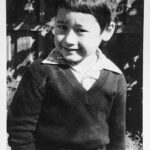I was very much moved by the generosity of spirit that motivated the creation of the Untitled.Showa project. Here we have 340 lost images concealing a forgotten history being unleashed across the world, like a phoenix rising from the ashes, as if orphans looking for parents, searching for a history, an identity and relevance.
During an Untitled.Showa workshop I was acquainted with the term “Kuyo” which is a ceremonial offering for the deceased. “Otakiage” is a type of “Kuyo,” which can involve the ritual burning of the possessions of people’s close relatives and friends. For us, in Australia these items usually end up in the op shop or the tip. For me, these things that were treasured by our loved ones, demand more respect and so the ritual of “Otakiage” struck a chord with me.
All of the participants in the workshop were asked to create a piece that reflects their feelings toward the Untitled Showa project.
Having thought about it carefully, I concluded that the project is about renewal and the resurrection of past lives. In fact it is the exact opposite of “Otakiage” where sad memories that are too sad to linger are cleansed and a view to a positive future is embraced.
I decided that I would burn a picture of my mother, Setsuko Nakamoto, who has long since passed away. By running the film backwards amidst the flames, her memory comes to life from the ashes giving a surreal and a ghostly effect. The subtle sound of birds calling amid the sound of the crackling flames reminds us of time’s relentless march forward.
Untitled.Showaプロジェクトを動機づけた精神的な寛大さに非常に感動しました。忘れ去られた歴史を秘めた340枚の失われた写真が、まるで灰の中から立ち上がる不死鳥のように、世界中に解き放たれるのです。まるで親を探している孤児のように、歴史、アイデンティティ、関連性を探しているかのように。
Untitled.Showaのワークショップで、「供養」という言葉をはじめて知りました。「お焚き上げ」は「供養」の一種であり、近親者や友人の持ち物を儀式的に燃やすことを意味します。オーストラリアの私たちにとって、これらの物は通常、セカンドショップに寄付したり、ゴミになったりしまいます。私は、大切な人が大切にしていたものには、敬意を払うべきだと思い、「お焚き上げ」の儀式に心を打たれました。
今回のワークショップでは、参加者全員にUntitled.Showaプロジェクトへの思いを込めた作品を作るようにと声をかけられました。
よくよく考えてみると、このプロジェクトは「再生」と「過去の人生の復活」を意味しているという結論に達しました。つまり、「お焚き上げ」とは正反対で、悲しすぎる思い出を浄化して、前向きな未来を見据えるものだと思います。
私は、とっくの昔に亡くなった母、ナカモトセツコの写真を焼くことにした。炎の中でフィルムを逆回転させると、灰の中から母の記憶が蘇り、シュールでゴーストのような効果が得られます。パチパチという炎の音の中、鳥の鳴き声がかすかに聞こえてきて、時の流れの速さを感じさせます。

Jim McFarlane ジム・マクファーレン
I was born to a Japanese mother who was one of the first Japanese war brides to settle in Melbourne post WW2. My elder sister Coral was born in Hiroshima and I was born in Melbourne. After working as a technical illustrator at the General Motors Tech Centre, I returned to school to study photography. A successful commercial career emerged and I became proficient in the arts, food and documentary photography. My works have been exhibited in more than 10 countries and I maintain a strong connection with Japan where I visit regularly to visit relatives and friends.
Jim’s Website: http://www.jimmcfarlanephotographer.com/
Story about Jim’s Mother and Family: https://www.nikkeiaustralia.com/nikkei-australian-family-history-by-jim-mcfarlane/
母は第二次世界大戦後にメルボルンに移住した最初の日本人戦争花嫁の一人でした。姉のコーラルは広島で生まれ、私はメルボルンで生まれました。ゼネラルモーターズの技術センターでテクニカルイラストレーターとして働いた後、学校戻り、写真を学びしました。商業写真家になり、その後、芸術、料理、ドキュメンタリー写真に精通するようになり、10カ国以上で作品を展示しました。日本とは強いつながりを続け、親戚や友人を訪ねて定期的に日本を訪れています。
ジムのウェブサイト:http://www.jimmcfarlanephotographer.com/
ジムの家族:https://www.nikkeiaustralia.com/nikkei-australian-family-history-by-jim-mcfarlane/
-Posted by Jim McFarlane November 2021
ー2021年11月、ジム・マクファーレン投函
Recent Comments